Never miss another geomagnetic storm. Sign up for Space Weather Alerts and you'll receive a text message when magnetic storms erupt. Aurora your guides and professional astronomers use this service. You can, too! | | |
QUIET SUN: Following months of almost uninterrupted solar activity, the sun is taking a break. Today there are only a handful of small sunspots, and not one of them poses a threat for strong flares. Solar flare alerts: SMS Text.
THE VENUS CLOUD DISCONTINUITY: A towering wall of acid clouds is racing through the atmosphere of Venus. Luigi Morrone photographed it from Agerola, Italy, on June 4th:
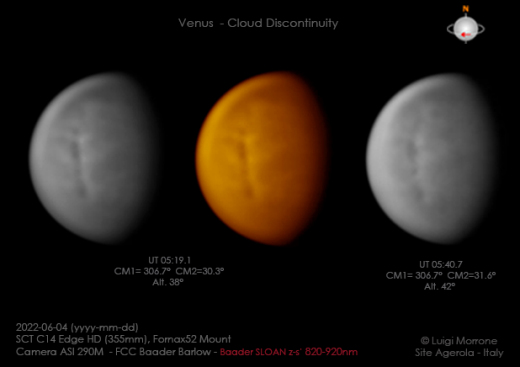
"It's called the Venus Cloud Discontinuity," says Morrone, who is part of an international network of amateur astronomers who have been tracking the massive structure. "I used a 14-inch Celestron telescope to record the discontinuity twice in 20 minutes."
The Venus Cloud Discontinuity is a relatively new discovery, photographed by Japan's Venus orbiter Akatsuki in 2016 and first spotted by JAXA scientist Javier Peralta. The massive structure cuts vertically across Venus's equator, stretching almost 5000 miles from end to end, and circles the planet faster than 200 mph, making one lap every ~5 Earth days.
Researchers following up on the discovery soon stumbled onto another surprise. Older photographs of Venus showed it, too. "[The Cloud Discontinuity] is a recurrent phenomenon that has gone unnoticed since at least the year 1983," they wrote in a May 2020 Geophysical Research Letter.
How do you overlook something so big? Visually, the Cloud Discontinuity is hidden underneath Venus's opaque cloudtops. To see it, you have to use an infrared filter, which reveals heat trickling up from below. Indeed, this is how amateurs are tracking the disturbance: "I used a Baader SLOAN 820-920nm near-infrared filter," notes Morrone.
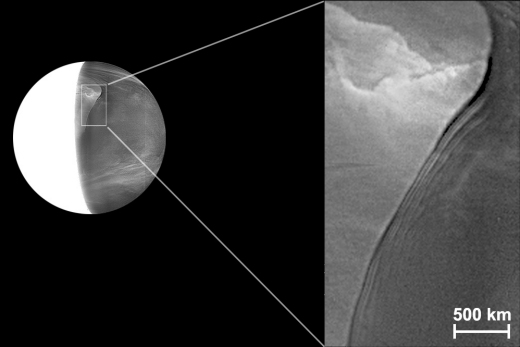
Above: Undulations behind the Cloud Discontinuity on April 15, 2016. Credits: Javier Peralta/JAXA-Akatsuki team. More images.
Researchers still aren't sure what the Cloud Discontinuity is. "This atmospheric disruption is a new meteorological phenomenon, unseen on other planets. Because of this it is difficult to provide a confident physical interpretation," says Peralta. Numerical simulations suggest that it might be some kind of exotic nonlinear Kelvin wave; the jury's still out.
Whatever it is, the structure might help solve a longstanding mystery: Why does Venus's atmosphere rotate so much faster than the planet itself? The hot, deadly air on Venus spins nearly 60 times faster than its surface, an effect known as "super-rotation." Venus's Cloud Discontinuity could be assisting the spin-up by transporting angular momentum from the deep atmosphere to the cloudtops.
Amateur astronomers, if you would like to monitor this phenomenon, check out the preprint "Amateur Observers Witness the Return of the Venus Cloud Discontinuity," which discusses observing techniques. Venus is waiting in the morning sky.
Realtime Space Weather Photo Gallery
Free: Spaceweather.com Newsletter
JEDI WINE GLASS: Father's Day is less than two weeks away. Are you looking for a far out gift? Consider the Jedi Wine Glass. This one hitched a ride to the stratosphere onboard a cosmic ray research balloon on June 1, 2022:
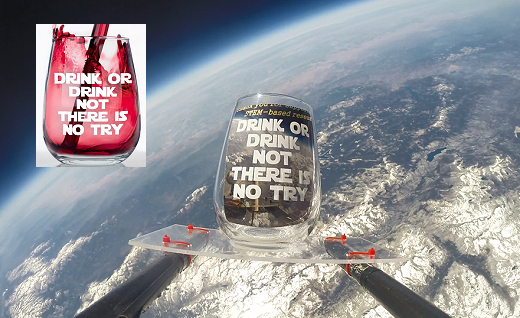
You can have it for $99.95. The funny stemless wine glass spent 2 hours floating in the stratosphere while cosmic ray sensors gathered data. It experienced temperatures as low as -63C and a vacuum-like air pressure only 0.2% of sea level.
The students of Earth to Sky Calculus are selling Jedi wine glasses to support their cosmic ray ballooning program. Each one comes with a greeting card showing the glass in flight and telling the story of its trip to the stratosphere and back again.
Far Out Gifts: Earth to Sky Store
All sales support hands-on STEM education
SOLAR CYCLE 25 (UPDATED): Once again, Solar Cycle 25 is exceeding predictions. Sunspot numbers in May 2022 were the highest in almost 8 years, more than doubling NOAA's official forecast:
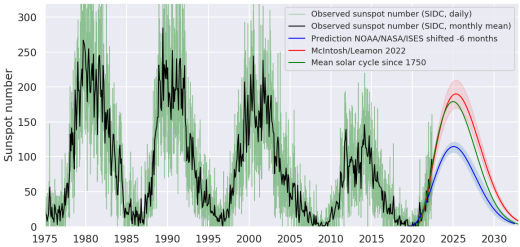
Image credit: Helio4cast, a group of scientists based in Austria working on basic and applied space weather research.
There is no longer any doubt that Solar Cycle 25 is on track to outperform its predecessor, historically weak Solar Cycle 24, which peaked in 2014.
The plot, above, compares current sunspot numbers to a selection of benchmarks. The blue curve is the "official forecast" issued by NOAA's Solar Cycle Prediction Panel in 2019. At the time, panel members anticipated a cycle similar to weak Solar Cycle 24. Zooming in shows how much the sun is overshooting that target.
The green curve is the average of all solar cycles since 1750, and the slightly taller red curve is a new prediction based on the Termination Event. Current sunspot counts match both. Even if Solar Cycle 25 turns out to be merely average, it will still far exceed previously low expectations. Stay tuned.
Realtime Space Weather Photo Gallery
Free: Spaceweather.com Newsletter
Realtime Aurora Photo Gallery
Free: Spaceweather.com Newsletter
Realtime Noctilucent Cloud Photo Gallery
Free: Spaceweather.com Newsletter
Every night, a network of
NASA all-sky cameras scans the skies above the United States for meteoritic fireballs. Automated software maintained by NASA's Meteoroid Environment Office calculates their orbits, velocity, penetration depth in Earth's atmosphere and many other characteristics. Daily results are presented here on Spaceweather.com.
On June 7, 2022, the network reported 8 fireballs.
(8 sporadic)
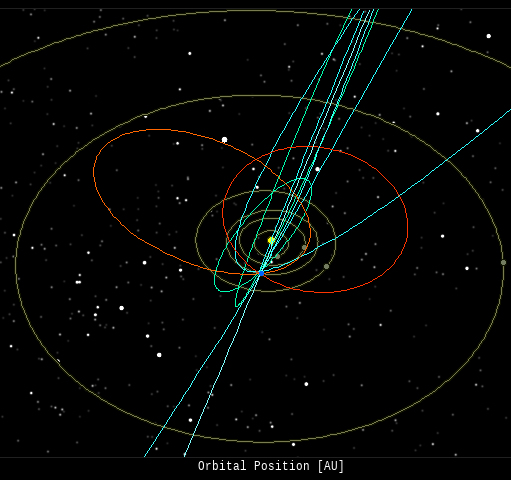
In this diagram of the inner solar system, all of the fireball orbits intersect at a single point--Earth. The orbits are color-coded by velocity, from slow (red) to fast (blue). [Larger image] [movies]
Potentially Hazardous Asteroids (
PHAs) are space rocks larger than approximately 100m that can come closer to Earth than 0.05 AU. None of the known PHAs is on a collision course with our planet, although astronomers are finding
new ones all the time.
On June 7, 2022 there were 2278 potentially hazardous asteroids.
 |
Recent & Upcoming Earth-asteroid encounters: | Asteroid | Date(UT) | Miss Distance | Velocity (km/s) | Diameter (m) |
| 2020 DA4 | 2022-Jun-02 | 5.5 LD | 9 | 27 |
| 2022 KP3 | 2022-Jun-02 | 3.4 LD | 7.2 | 7 |
| 2022 KN5 | 2022-Jun-02 | 4.2 LD | 18.1 | 20 |
| 2022 LJ | 2022-Jun-02 | 2.3 LD | 19.1 | 22 |
| 2022 KO5 | 2022-Jun-02 | 16.7 LD | 5.8 | 23 |
| 2022 KD2 | 2022-Jun-03 | 6.4 LD | 6.8 | 45 |
| 2022 KH1 | 2022-Jun-03 | 12.5 LD | 9.6 | 28 |
| 2022 KC4 | 2022-Jun-03 | 5.2 LD | 11.5 | 19 |
| 2022 KJ3 | 2022-Jun-03 | 17.9 LD | 7.7 | 29 |
| 2022 KZ5 | 2022-Jun-04 | 8.3 LD | 9.1 | 18 |
| 2022 LB | 2022-Jun-04 | 12.5 LD | 9.3 | 27 |
| 2022 KM6 | 2022-Jun-04 | 3 LD | 21 | 21 |
| 2022 LE1 | 2022-Jun-05 | 7 LD | 16.1 | 24 |
| 2022 KB3 | 2022-Jun-06 | 2.9 LD | 11.9 | 17 |
| 2021 GT2 | 2022-Jun-06 | 9.5 LD | 7.5 | 50 |
| 2022 KV3 | 2022-Jun-07 | 17.8 LD | 3.9 | 23 |
| 2022 LU1 | 2022-Jun-08 | 9.4 LD | 5.3 | 12 |
| 2022 KV1 | 2022-Jun-08 | 11.2 LD | 15.2 | 61 |
| 2018 LU2 | 2022-Jun-09 | 14.8 LD | 10.7 | 16 |
| 2022 KM1 | 2022-Jun-09 | 16.3 LD | 11.2 | 42 |
| 2022 LP | 2022-Jun-10 | 5.8 LD | 12.3 | 32 |
| 2022 KC3 | 2022-Jun-10 | 6.4 LD | 4.6 | 17 |
| 2022 LL1 | 2022-Jun-11 | 7.2 LD | 23.9 | 26 |
| 2022 LU | 2022-Jun-11 | 11.8 LD | 20.2 | 32 |
| 2006 XW4 | 2022-Jun-12 | 5.9 LD | 7.3 | 49 |
| 2022 GU6 | 2022-Jun-12 | 3.2 LD | 8.4 | 86 |
| 2015 LK | 2022-Jun-13 | 13.6 LD | 8.7 | 31 |
| 2022 LX | 2022-Jun-22 | 10.4 LD | 10.1 | 35 |
| 2022 LS1 | 2022-Jun-23 | 18.9 LD | 9.9 | 35 |
| 2022 LV | 2022-Jun-25 | 2 LD | 3.6 | 22 |
| 2015 WP2 | 2022-Jun-26 | 18.5 LD | 11.4 | 3 |
| 2022 JE1 | 2022-Jul-03 | 8.6 LD | 5.6 | 74 |
| 2021 EL4 | 2022-Jul-05 | 19.8 LD | 9.5 | 25 |
| 2015 OQ21 | 2022-Jul-12 | 18.3 LD | 6.6 | 9 |
| 2022 LR1 | 2022-Jul-16 | 9.3 LD | 4.7 | 42 |
| 2022 KY4 | 2022-Jul-17 | 15.9 LD | 7.5 | 91 |
| 2021 OT | 2022-Jul-17 | 16.5 LD | 11.2 | 20 |
| 349068 | 2022-Jul-19 | 17.6 LD | 22.9 | 756 |
| 2017 RX2 | 2022-Jul-24 | 17.2 LD | 14.2 | 17 |
| 2016 CZ31 | 2022-Jul-29 | 7 LD | 15.6 | 129 |
| 531944 | 2022-Jul-30 | 18.2 LD | 5.9 | 192 |
| 2020 PP1 | 2022-Aug-01 | 13.1 LD | 3.7 | 17 |
| 2020 PN1 | 2022-Aug-03 | 9.7 LD | 4.6 | 29 |
Notes: LD means "Lunar Distance." 1 LD = 384,401 km, the distance between Earth and the Moon. 1 LD also equals 0.00256 AU. MAG is the visual magnitude of the asteroid on the date of closest approach. | | Cosmic Rays in the Atmosphere |
SPACE WEATHER BALLOON DATA: Almost once a week, Spaceweather.com and the students of Earth to Sky Calculus fly space weather balloons to the stratosphere over California. These balloons are equipped with sensors that detect secondary cosmic rays, a form of radiation from space that can penetrate all the way down to Earth's surface. Our monitoring program has been underway without interruption for 7 years, resulting in a unique dataset of in situ atmospheric measurements.
Latest results (Nov. 2021): Our balloons have just measured a sudden drop in atmospheric radiation. It happened during the strong geomagnetic storms of Nov. 3-4, 2021. Here are the data:
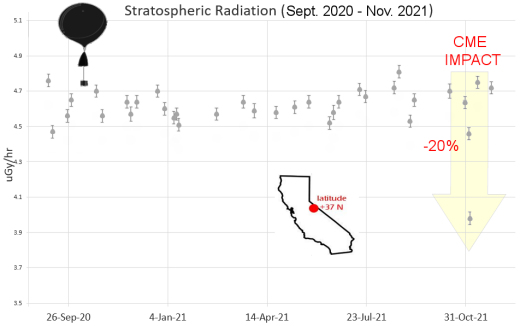
This is called a "Forbush decrease," named after American physicist Scott Forbush who studied cosmic rays in the early 20th century. It happens when a CME from the sun sweeps past Earth and literally pushes cosmic rays away from our planet. Radiation from deep space that would normally pepper Earth's upper atmosphere is briefly wiped out.
We have measured Forbush decreases before. For example, here's one from Sept. 2014. The Forbush Decrease of Nov. 3-4, 2021, was the deepest in the history of our 7-year atmospheric monitoring program. Radiation levels in the stratosphere over California dropped nearly 20%, more than doubling the previous record from our dataset.
En route to the stratosphere, our sensors also pass through aviation altitudes, so we can sample radiation where planes fly. This plot shows how the Forbush decrease was restricted to the stratosphere; it did not affect lower levels of the atmosphere:
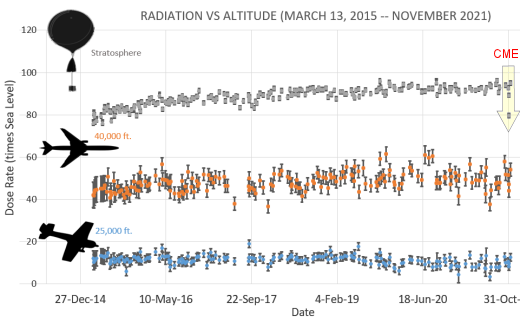
The dose rates shown above are expressed as multiples of sea level. For instance, we see that boarding a plane that flies at 25,000 feet exposes passengers to dose rates ~10x higher than sea level. At 40,000 feet, the multiplier is closer to 50x. The higher you fly, the more radiation you will absorb.
.Who cares? Cosmic rays are a surprisingly "down to Earth" form of space weather. They can seed clouds, trigger lightning, and penetrate commercial airplanes. According to a study from the Harvard T.H. Chan school of public health, crews of aircraft have higher rates of cancer than the general population. The researchers listed cosmic rays, irregular sleep habits, and chemical contaminants as leading risk factors. Somewhat more controversial studies (#1, #2, #3, #4) link cosmic rays with cardiac arrhythmias and sudden cardiac death.
.Technical notes: The radiation sensors onboard our helium balloons detect X-rays and gamma-rays in the energy range 10 keV to 20 MeV. These energies span the range of medical X-ray machines and airport security scanners.
Data points in the first graph ("Stratospheric Radiation") correspond to the peak of the Regener-Pfotzer maximum, which lies about 67,000 feet above central California. When cosmic rays crash into Earth's atmosphere, they produce a spray of secondary particles that is most intense at the entrance to the stratosphere. Physicists Eric Regener and Georg Pfotzer discovered the maximum using balloons in the 1930s and it is what we are measuring today.
| | The official U.S. government space weather bureau |
| | The first place to look for information about sundogs, pillars, rainbows and related phenomena. |
| | Researchers call it a "Hubble for the sun." SDO is the most advanced solar observatory ever. |
| | 3D views of the sun from NASA's Solar and Terrestrial Relations Observatory |
| | Realtime and archival images of the Sun from SOHO. |
| | information about sunspots based on the latest NOAA/USAF Active Region Summary |
| | from the NOAA Space Environment Center |
| | fun to read, but should be taken with a grain of salt! Forecasts looking ahead more than a few days are often wrong. |
| | from the NOAA Space Environment Center |
| | the underlying science of space weather |
 | Going above and beyond to provide the best homes listings in the Comox real estate market to keep you up to date and informed |
 | BestCSGOGambling is the best site for everything related to CSGO gambling on the web |
 | To find reviews of new online casino sites in the UK try The Casino DB where there are hundreds of online casino reviews complete with bonuses and ratings. Alternatively, Online-Casinos.xyz is another massive directory of online casinos listing sites for the UK and Worldwide. Casinos that offer Rupees for bonuses are very generous to Indian players. Find the best online casinos in India at AllCasinos.in Looking for a new online casino? Try Casimpo the new site dedicated to making online casino simple, or check out the new Avenger Slots Casino and Ace Online Casino with over 500 online slots and casino games. |
 | One of the most popular casino games is the Book Of Dead Slot based on ancient Egyptian text, you can find all the casinos with spins at bookofdeadslotsites.com. |
 | When looking for casinos to play online when the weather is bad, you can try casino online trucchi for Italian games. If you are not from Finland you can try the Swedish page Svenska casino online to find suitable games, check out svenskacasinoonline.net. Always check your local laws before playing with real money. |
 | Looking for sports betting companies not registered on GamStop? CasinoGap has presented a list of sites not on GamStop available for UK players. Check and bet online! Would you like to bet at sites not using GamStop? Look at a list of NonStopCasino sites for online betting that aren't on GamStop. Top-rated bookmakers ever! |
| | These links help Spaceweather.com stay online. Thank you to our supporters! |
| | | | | | |

